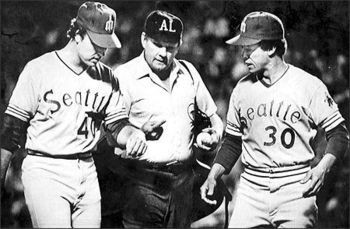|
When Michael Piñeda of the Yankees was caught with pine tar on the back of his neck the other day, my thoughts flashed back to a high-school football game I covered, oh, a few years ago.
In bright sunshine, with witnesses in the stands, a defender put the slug on an opponent – on the 50-yard line. The referee tossed him. After the game, the crusty old coach told the wave of reporters (that is to say, me), “Geez, I told the guy, don’t do stuff like that in the middle of the field.” The operative phrase was, “in the middle of the field.” Whack the guy in the bottom of the pile. Knee him. Gouge him. But, geez, not in full view. They all know. That’s my theory about sports. Coaches have a pretty good idea what their players are up to but cannot afford to “know.” During the great steroid frolics, owners and general managers did everything but administer the injections. (Looking back, I heard one owner make creatine jokes before I knew what he was talking about, and one terrific player talk about a “major-league coffee” before a game.) Some of the best people I have known in baseball relied on little tricks of the trade. Rick Honeycutt used a tack in his glove to cut the baseballs, alter their aerodynamics. Got caught by the home-plate umpire, Bill Kunkel, himself a former pitcher. Geez, not in the middle of the field. http://www.nytimes.com/1984/05/25/sports/sports-of-the-times-rich-honeycutt-is-sharp-again.html Rick is a great guy, now in his ninth year as the Dodgers’ pitching coach. I once saw Elston Howard set a world record for a lumbering catcher in full gear sprinting from home plate to the dugout tunnel after catching one hellacious curve from Whitey Ford for the last strike against the Tigers. Elston took the ball with him, I might add, and was on the George Washington Bridge heading home to the beautiful Arlene Howard before the Tigers could scream for the ball – and Elston’s belt buckle, which was filed to nearly lethal sharpness. And so it goes. Briana Scurry moved forward from the line to smother a penalty kick during the shootout for the final of the 1999 Women’s World Cup. The referee did not notice, or chose not to notice, Scurry’s dancing feet. The U.S. beat China a minute later. Donna Lopiano, then of the Women’s Sports Foundation, and one of the strong, ethical voices in sport, called Scurry’s move cheating. I called it gamesmanship and wrote a whole column about it: http://www.nytimes.com/1999/08/08/sports/backtalk-when-is-it-gamesmanship-and-when-is-it-cheating.html Everybody in baseball knows what pitchers do, as Tyler Kepner writes in the Friday Times. http://www.nytimes.com/2014/04/25/sports/baseball/missing-on-mound-a-dab-of-discretion.html Piñeda deserved the 10-game suspension not so much for cheating but for a worse violation. Tontería. Stupidity. Geez, not in public. Your thoughts?
Ed Martin
4/25/2014 02:07:51 pm
How do I game thee? Let me count the ways...
George Vecsey
4/26/2014 02:19:45 am
Ed, exactly.
John McDermott
4/26/2014 07:33:37 pm
My attitude-sharply focused after getting a red card for retaliating against an opponent for a nasty off-the-ball foul was was not seen by the ref-was to always make sure you got even, just don't do it right away, obviously or when everyone is looking. Pelé was a master at paying defenders back and somehow always made it look like an innocent accident, even helping his victims to their feet and apologizing. But he knew exactly what he was doing. As I once heard an Italian ref say to a player who had committed a particularly stupid and harsh foul early in a game, "Listen son, I don't want to put anyone out of the game today, so please don't put me in the position where I have to do that, OK?" 4/27/2014 05:23:13 am
It is a combination of gamesmanship and common sense, particularly when the act is probably in plain view. As a goalkeeper who never once was a field player in ten years, I did not experience the push and shove of challenging an attacker or defender. However, we need to utilize every possible advatage to gain an edge and intimidate an attacker.
George Vecsey
4/27/2014 02:56:33 pm
Alan, you're a regular Toni Schumacher. 4/27/2014 04:11:03 pm
If I knew that Toni would have seen the highlights of the Lehigh-Muhlenburg game, I would have been more careful.
Ed Martin
4/28/2014 01:06:33 pm
Lehigh, in Alan's day, was primarily an engineering school, so it is not surprising Alan misspelled MuhlenbErg. 4/28/2014 03:57:45 pm
Ed--spelling was one of the major reasons for taking engineering. That crashed freshman year with two theme writing courses. Even with today's spell check, I often have trouble getting close enough to get a correction.
Ed Martin
4/29/2014 03:47:11 am
Alan. LeHI may not have had a spelling major, but they did turn out gentlemen and scholars and goalies.
bruce
4/29/2014 09:37:41 am
it was very odd. I kept on thinking, 'what the hell as HE thinking?'.....no subtlety at all. deserved to be caught just for being dumb. Comments are closed.
|
Categories
All
|










